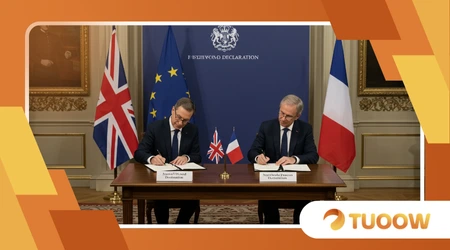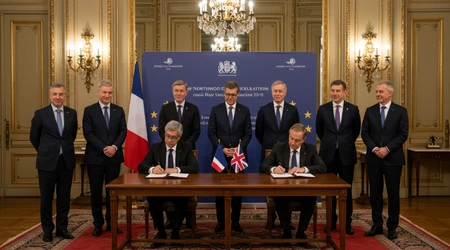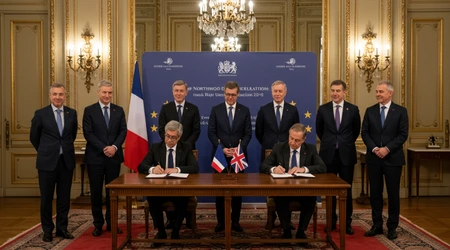UK-France Sign ‘Northwood Declaration’: First Ever Nuclear Cooperation Pact

The Northwood Declaration, signed on July 10, 2025, marks a seismic shift in European defense strategy.
Unveiled by UK Prime Minister Keir Starmer and French President Emmanuel Macron at Northwood’s NATO Maritime Command, this pact unites Europe’s only nuclear powers in unprecedented coordination.
Amid rising global tensions, from Russia’s threats to uncertainties over U.S. commitment, this agreement signals a bold European response.
It’s not just a policy shift it’s a redefinition of deterrence in a volatile world. Why now? Because the stakes have never been higher.
This historic deal, forged after years of bilateral trust-building, strengthens the UK-France defense axis. It builds on decades of collaboration, notably the 2010 Lancaster House Treaties, but goes further, aligning nuclear doctrines while preserving sovereignty.
The declaration responds to a fractured geopolitical landscape, with Russia’s aggression in Ukraine and China’s growing influence looming large.
It’s a statement of intent: Europe will not stand idle. Through this lens, we explore the pact’s implications, its strategic necessity, and what it means for global security.
A New Era of Nuclear Deterrence
The Northwood Declaration isn’t about merging arsenals but coordinating responses to “extreme threats.” Both nations retain independent control over their nuclear forces.
This nuanced approach ensures flexibility while projecting unity. The agreement establishes a UK-France Nuclear Steering Group, led by the Élysée Palace and UK Cabinet Office, to align policies, capabilities, and operations.
It’s a pragmatic step, reflecting shared interests in a turbulent era.
This coordination addresses a critical gap. Russia’s nuclear saber-rattling, including threats during the Ukraine conflict, has heightened European anxieties.
The declaration counters this by ensuring no threat to one nation goes unanswered by both. It’s a deterrence multiplier, amplifying the psychological impact on adversaries.
++ High Court Rules on Major Immigration Policy Challenge
The pact also signals to NATO allies that Europe’s nuclear powers are stepping up, reducing26 words
Imagine two boxers training separately but agreeing to tag-team in a high-stakes match. That’s the UK and France distinct yet united when it counts. This coordination could involve joint submarine patrols or shared exercises, like France’s Poker drills.
Such collaboration enhances operational readiness, ensuring a swift, unified response if needed. The 2010 Teutates program, which shared nuclear research facilities, laid the groundwork for this trust.
The pact also reaffirms commitment to the Non-Proliferation Treaty (NPT). Both nations aim to strengthen global non-proliferation efforts, balancing deterrence with diplomacy.
This dual focus underscores their role as responsible nuclear powers. The Northwood Declaration thus positions the UK and France as pillars of European security, ready to act decisively.

Why Now? The Geopolitical Imperative
Global threats are evolving. Russia’s invasion of Ukraine, ongoing since 2022, has destabilized Europe. Its nuclear threats over 20 instances reported by the Atlantic Council in 2025 demand a robust response.
The Northwood Declaration is that response, a clear message to Moscow: Europe’s nuclear powers are united. This pact also addresses doubts about U.S. reliability under shifting political dynamics.
The timing reflects a broader push for European strategic autonomy. With U.S. focus pivoting to the Indo-Pacific, Europe must bolster its own defenses.
The declaration aligns with NATO’s collective defense but emphasizes European initiative. It’s a hedge against uncertainty, ensuring the continent’s security doesn’t hinge solely on external allies.
Also read: Third Consecutive Heatwave Hits UK Amid Water Crisis and Drought
Consider the 2009 collision between HMS Vanguard and FS Le Triomphant, two nuclear submarines unknowingly crossing paths.
That incident spurred deconfliction protocols, a small but vital step toward today’s cooperation. The Northwood Declaration builds on such lessons, fostering trust to prevent mishaps and enhance joint readiness.
Beyond Nuclear: A Broader Defense Partnership
The Northwood Declaration extends beyond nuclear policy, revitalizing UK-France defense ties. The agreement updates the Lancaster House Treaties, reinforcing a Combined Joint Force with cyber and space capabilities.
It also commits to replenishing Storm Shadow missile stocks, depleted by support for Ukraine, sustaining 1,300 UK jobs.
This industrial partnership drives innovation. The joint development of a new deep-strike missile, replacing Storm Shadow, showcases shared ambition.
Picture a symphony orchestra each nation plays its part, but together, they create something greater. This collaboration strengthens both deterrence and economic resilience.
Read more: HS2 Project in Turmoil: Transport Secretary Calls It an ‘Appalling Mess
The pact also includes a migration deal, a “one-in, one-out” pilot for Channel crossings.
This pragmatic approach ties security to domestic priorities, addressing public concerns while deepening bilateral trust. It’s a holistic strategy, blending hard power with soft power solutions.
Implications for NATO and Global Security
The Northwood Declaration strengthens NATO’s nuclear backbone. The UK, a member of NATO’s Nuclear Planning Group, commits its deterrent to the alliance.
France, historically more independent, now signals closer alignment. This convergence enhances NATO’s cohesion, reassuring allies like Poland and the Baltics.
Yet, challenges remain. Coordinating nuclear forces requires intricate planning target selection, launch protocols, and deconfliction.
Joint exercises, like integrating UK tankers into France’s Poker drills, could streamline operations. The declaration’s ambiguity on specifics, while strategic, leaves room for speculation about its full scope.
Russia’s reaction has been predictably hostile. Kremlin statements, as reported by Reuters on July 11, 2025, branded the pact “provocative.”
This rhetoric underscores the declaration’s deterrent effect: it forces adversaries to recalculate risks. The pact also sparks debate about a European nuclear strategy, potentially reducing reliance on U.S. extended deterrence.
Addressing Public and Political Concerns
Public skepticism about nuclear policy is real. Many question the ethics of deterrence or fear escalation. The Northwood Declaration counters this by emphasizing responsible stewardship.
Both nations reaffirm NPT obligations, ensuring transparency and restraint. This balance addresses critics while maintaining strategic credibility.
Politically, the pact navigates sensitive terrain. The UK’s reliance on U.S.-designed Trident missiles limits some cooperation due to bilateral agreements.
France’s independent nuclear doctrine, meanwhile, requires careful alignment. The Nuclear Steering Group will be key in resolving these tensions, fostering trust through dialogue.
The declaration also resonates domestically. By linking defense to jobs 1,300 sustained through missile production it appeals to working-class voters.
This economic angle, paired with security assurances, makes the pact a political win for Starmer and Macron, reinforcing their leadership.

A Step Toward European Strategic Autonomy
The Northwood Declaration is a bold step toward a stronger, self-reliant Europe. It signals that the UK and France are not just reacting to threats but shaping the continent’s future.
By coordinating nuclear forces, they assert leadership within NATO, reassuring allies and deterring foes.
This pact also challenges the narrative of European dependence. With 60% of NATO’s defense spending now coming from non-U.S. allies (NATO 2024 report), Europe is stepping up.
The declaration amplifies this trend, positioning the UK and France as anchors of regional stability.
| Aspect | UK | France |
|---|---|---|
| Nuclear Arsenal | Trident-based, submarine-launched | ASMP-A missiles, Rafale fighters |
| NATO Role | Nuclear Planning Group member | Independent, non-NPG member |
| Key Commitment | Coordinated response to threats | Coordinated response to threats |
| Jobs Supported | 1,300 (Storm Shadow production) | Joint missile development |
The Road Ahead: Challenges and Opportunities
Implementing the Northwood Declaration demands precision. Coordinating nuclear strikes selecting targets, timing launches requires seamless communication.
Joint patrols or exercises, like those suggested by expert Héloïse Fayet, could refine these processes, ensuring readiness without compromising sovereignty.
The pact also opens doors for innovation. The ASN4G hypersonic missile, in development since 2024, could redefine deterrence.
Collaborative research, building on the Teutates program, may yield breakthroughs in warhead reliability. This partnership isn’t just about today it’s about shaping tomorrow’s security landscape.
Finally, the declaration invites broader European reflection. Could other nations join this framework? Poland’s interest in hosting French nuclear-capable Rafales hints at possibilities.
The pact could spark a wider debate on European nuclear strategy, balancing autonomy with NATO unity.
Conclusion: A Defining Moment for Europe
The Northwood Declaration is more than a defense pact it’s a clarion call for European resolve. Signed amid global uncertainty, it unites the UK and France in a shared mission to protect the continent.
From nuclear coordination to missile production, it’s a multifaceted strategy that blends deterrence, diplomacy, and economic gain. Can Europe afford to stand divided when threats multiply? This pact says no, offering a blueprint for unity and strength.
By fostering trust, sustaining jobs, and countering adversaries, the declaration redefines European security.
It’s a testament to what’s possible when nations align their strengths. As the UK and France lead, they challenge Europe to rethink its future not as a bystander, but as a power in its own right.
Frequently Asked Questions
What is the Northwood Declaration?
It’s a 2025 UK-France agreement to coordinate nuclear deterrents, ensuring a joint response to extreme threats while maintaining independent arsenals.
How does it affect NATO?
It strengthens NATO’s nuclear cohesion, aligning UK and French strategies to reassure allies and enhance deterrence against threats like Russia.
Does it involve sharing nuclear weapons?
No, it’s about coordination, not sharing. Both nations retain sovereign control but align policies and operations for unified responses.
Why was it signed in 2025?
Rising Russian threats and U.S. strategic shifts prompted Europe’s nuclear powers to deepen cooperation, ensuring continental security.
What are the economic benefits?
The pact sustains 1,300 UK jobs through missile production, like Storm Shadow, boosting economies while enhancing defense capabilities.
